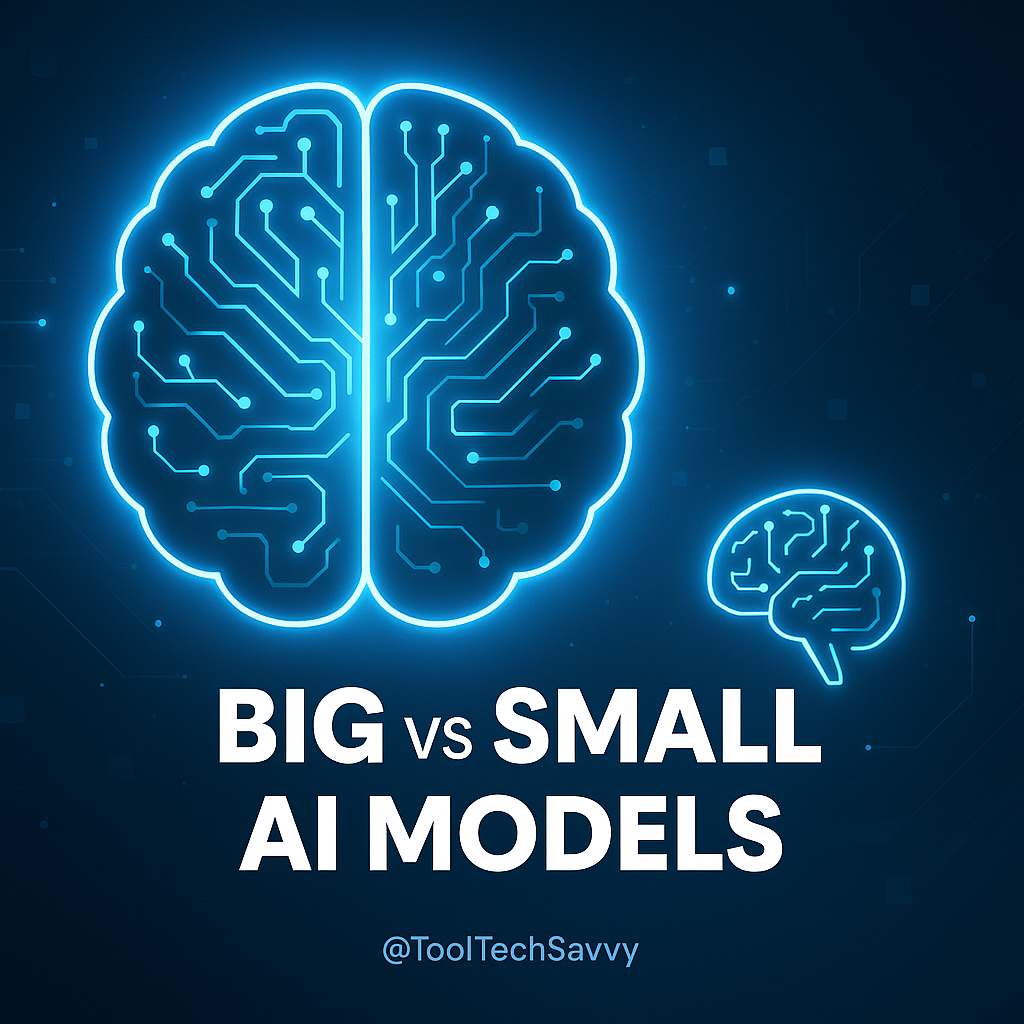For years, the AI race was about one thing — size. Every new release promised more parameters, longer context windows, and bigger performance leaps. But in 2025, that narrative is starting to change.
Enter Small Language Models (SLMs) — lightweight, efficient, and increasingly powerful. These models challenge the “bigger is better” mindset by offering speed, privacy, and affordability without the heavy compute demands.
If you’ve been following developments like Meta’s open-source LLMs, read Meta’s New Open-Source LLM: What It Means for AI Innovation to see how open AI ecosystems are paving the way for smarter, smaller alternatives.
What Are Small Language Models (SLMs)?
A Small Language Model is essentially a compact version of a large model — trained on fewer parameters and often fine-tuned for specific tasks.
Instead of trying to “know everything,” an SLM focuses on doing one thing well — like summarizing text, writing emails, or answering FAQs.
Examples of SLMs
- Phi-3 Mini (Microsoft) — designed for reasoning with high efficiency.
- Gemma (Google) — open-weight and fine-tunable for lightweight AI projects.
- Mistral 7B — an open-source model that rivals much larger ones in performance.
If you’re just getting into AI development, check out Step-by-Step: How to Experiment with Open-Source AI Models (Free Tools) to try these models hands-on.
Why “Bigger” Isn’t Always Better
While large models like GPT-4 and Claude 3 are unmatched in versatility, they come with trade-offs:
- High latency (they’re slower).
- Expensive inference costs.
- Significant hardware requirements.
- Privacy concerns when using cloud-based APIs.
SLMs, in contrast, excel in real-world practicality — the sweet spot between performance and efficiency.
The Advantages of Small Language Models
1. Speed and Efficiency
SLMs run faster on smaller devices, making them ideal for edge computing or on-device AI. You can deploy them on laptops or even smartphones.
For developers setting up local AI, this pairs perfectly with Ollama vs LM Studio: Which Is Best for Local LLMs?.
2. Cost Savings
Smaller models consume less memory and compute power, reducing API or GPU costs — critical for startups and solo developers optimizing budgets.
Learn more about optimizing expenses in Scaling AI Efficiently: The Ultimate Guide to Production Cost Savings.
3. Privacy and Control
SLMs can run offline, keeping sensitive data local. For industries like healthcare or finance, this is a massive win.
4. Easier Fine-Tuning
Because of their smaller size, SLMs are easier and cheaper to fine-tune for custom use cases — from customer support to code generation.
See How to Train Your Own AI Chatbot with Your Data (Beginner-Friendly) for a step-by-step tutorial.
When to Choose an SLM Over an LLM
Choosing between an SLM and an LLM depends on your goals.
| Use Case | Recommended Model | Why |
|---|---|---|
| Fast, local tasks | SLM | Lightweight and quick to deploy |
| Complex reasoning or creativity | LLM | Broader knowledge and context depth |
| Offline applications | SLM | No internet or API dependency |
| Automation workflows | SLM | Integrates easily with low-code tools |
| Multi-language or nuanced writing | LLM | Handles diverse, abstract tasks |
If your workflow involves automation, check out How to Use ChatGPT and Zapier to Automate Your Content Calendar — where smaller AI tools can do the heavy lifting efficiently.
How Developers Are Using SLMs in 2025
From edge-AI applications to no-code integrations, developers are rethinking how AI fits into daily work.
For instance, combining SLMs with agentic AI frameworks allows smarter task execution with minimal resources. To learn more about this movement, read How to Adopt the Agentic AI Mindset in 2025.
Moreover, using RAG (Retrieval-Augmented Generation) with SLMs allows them to access external data without retraining — expanding their knowledge dynamically. See Unlock Smarter AI: A Beginner’s Guide to RAG and Vector Databases.
The Future: A Hybrid AI Landscape
The future isn’t small vs large — it’s hybrid.
Developers will increasingly combine small, efficient models with large, cloud-based ones depending on the task.
For example:
- Use an SLM for fast text extraction or summarization.
- Use an LLM for creative or high-context generation.
This hybrid trend reflects what’s happening across industries — a theme explored in The Future Is Hybrid: Everything You Need to Know About Multi-Modal AI.
Smart Efficiency Over Raw Power
The AI world is finally realizing that more isn’t always better.
Small Language Models prove that efficiency, adaptability, and focus can outperform size — especially when paired with the right workflows and data strategies.
So, the next time you choose between GPT-4 and a 7B-parameter model, remember: sometimes, the smaller brain thinks faster and smarter.
To learn how to make AI work efficiently in your setup, start with The 80/20 Rule in AI Learning: Focus on What Actually Matters — your shortcut to mastering AI productivity.



